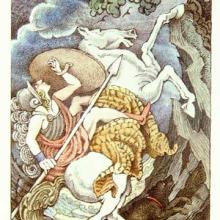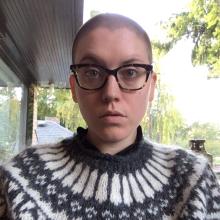This year-long seminar was structured around the idea that the concept of the Anthropocene challenges us to rethink our basic humanistic values: the centrality of speech for human expression, rational thought, the ability to reason and communicate, the demand for freedom, democracy, justice and human rights, and the creation of cultural expressions based on enlightenment values.
Bi-weekly discussions of select readings and projects were the base for intense reflections. We also met with visitors whose work we read in advance. We started examining Donna Haraway’s Staying with Trouble, spent and entire session on readings about Mosquitoes, which was followed by a field trip to the spider collection in the Burke Museum; we also discussed Mel Chen’s work on Animacies: Biopolitics, Racial Mattering, and Queer Affect and read excerpts from Jacob von Uexküll’s Foray into the Worlds of Animals and Humans.
In winter quarter we studied Animal Epitaphs in Roman poetry, spent a session on rocks and enjoyed a visit by my colleague Jason Groves and learned about his project on the Mineral Imagination. We saw Lucy Kirkwood’s play “The Children” in the Seattle Repertory Theater, read Wordsworth’s poetry, and attended Anna Tsing’s lecture on “Feral Atlas and the More-than-Human Anthropocene.” The quarter concluded with a discussion of Werner Herzog’s documentaries with Eric Ames from Cinema & Media Studies.
In spring Amos Nascimento from UW/Tacoma shared with us his work on Environmental Cosmopolitanism and Maria Elena Garcia from Comparative History of Ideas introduced us to Indigenious Critical Animal Studies and Inter-Species Thinking. I hope you enjoy reading more about the students’ profiles and projects below.
-------------------------------------------------------
Matthew Childs is a PhD Candidate in the Department of Germanics. He is also a teaching assistant for German language courses at the beginning and intermediate levels. He has several areas of research, including ecocriticism, the decolonization of German Studies, and German literature and philosophy of the eighteenth- and nineteenth centuries. These areas of research coincide in his dissertation work on nineteenth-century German disaster narratives.
His dissertation project, tentatively titled Catastrophes and Crises: An Analysis of Disaster Narratives in Nineteenth-Century German Literature, examines the ways in which disaster narratives written between 1807 and 1888 reflect the anxieties that pervaded society at a time of immense social, political, and economic upheaval. The primary claim is that literary representations of disasters, both human and man-made, fulfill a number of critical functions. They can act as a mechanism for moral development, an adversary whose dialectical opposition to human power forces human beings to strive for greater technological mastery, and a foil against the arrogance of human beings. A recent development, stemming from the visit of Professor Amos Nascimento (UW Tacoma) to a Hanauer seminar, is the application of ecosemiotics in determining how figures from these narratives “read” the events of disaster.
----------------------------------------------
Justin Mohler is a PhD candidate in the Department of Germanics. His research focuses on the interrelation of artistic and scientific depictions of animals. He is currently working on a dissertation project entitled “Beastly Specters: from Hubris to Hybridity in German Romanticism and Beyond.” The project examines literary representations of non-human animals at a time during which their role in the human sphere was fundamentally transformed. Looking ahead, the dissertation also explores the ways in which this discourse surrounding the animal-human divide has been inherited and amplified by contemporary works of literature in ways that continue to shape our encounters with one another.
------------------------------------------
Jingsi Shen is a fourth-year PhD student in Comparative Literature at the University of Washington. Her research interests include 18th- and 19th-century British and German literature and classical reception. She is currently working on her dissertation which looks into different ways of conceiving the intimacy of mind and body in works of several Romantic writers. Partly influenced by intellectual traditions such as panpsychism and Spinozism, a lot of authors writing in the Romantic era had a strong tendency toward non-dualism. This project then focuses on literary texts that put bodies under difficult conditions where they assume a kind of borderline existence: between categories of human and non-human, animate and inanimate, material and immaterial, and ultimately between life and death.
---------------------------------------------
Maxine Savage is a doctoral student in Scandinavian Studies at the University of Washington, specializing in contemporary Icelandic literature and cinema. Their research examines the sexual and racial formation of Icelandic national identity, and explores the contemporary negotiation of the human, considering axes of class, race, sexuality, gender, materiality, and citizenship. Part of their dissertation poses Icelandic queer cinema as an active archive for this exploration, considering national belonging from the perspective of animacy. They survey the trend of anal intercourse in flesh and stone within literary and cinematic reception of national independence, in which bodies, both lively and inorganic, are figured as sites of colonial power relations.
-----------------------------------------------
Mandy McCourt is a fifth-year PhD candidate in the Department of English, where she also works as an instructor for composition classes. She grew up in Fargo, ND, and attended Gustavus Adolphus College. She is currently working on her dissertation that analyzes new wave science fiction (SF) as an inward turning form of the genre, and articulates this literary movement in complex relation to the American counterculture of the 1960s and 1970s.
In a gloss, her dissertation aims to define the centrality of speculative aesthetics within the wider field. The project cites a selection of new wave SF by Philip K. Dick, Octavia E. Butler, and Kathy Acker against a backdrop of new age practices in case studies on drugs, cults, and cut-ups. The line of inquiry concerns itself with the two-way traffic between popular culture and protest movements to better understand how transformative political projects are crosscut with practices of everyday life. It adopts an ethnographic approach toward popular literacies and fan practices, which takes seriously and recuperates value for a set of (mis)readings that move people nevertheless. By examining feedback processes that cycle between agents and structures, the paper tracks how large-scale abstractions materialize through literal points of contact. Drugs, cults, and cut-ups are performative practices that combine two categories that Jakob von Uexkull uses to different types of tools: there are aids to action [Werkzeuge] and to perception [Merkzeuge] in his model. If action and perception co-create an interface between an organism and its environment, then a broad framework that integrates theories of cybernetics and biosemiotics might reformulate subject-object relations.
-----------------------------------------------
Grace Funsten is a PhD candidate in the Department of Classics. Her research examines receptions of Augustan elegy, composed 43 BCE – 17 CE, in antiquity and in early modern France. One of these receptions is the use of the erotic language of elegy in poetic epitaphs from the Roman empire for domestic animals like dogs.
The goal of her Hanauer project was to familiarize the participants with Roman funerary practices before discussing a selection of epitaphs for dogs. Participants examined typical Roman burial practices for humans across different times and social classes, and then turned their attention to funerary portraits and poetic epitaphs for dogs. Discussion centered on how these burial markers for domestic animals drew on human funerary practices and why humans might choose to memorialize an animal in this way.









